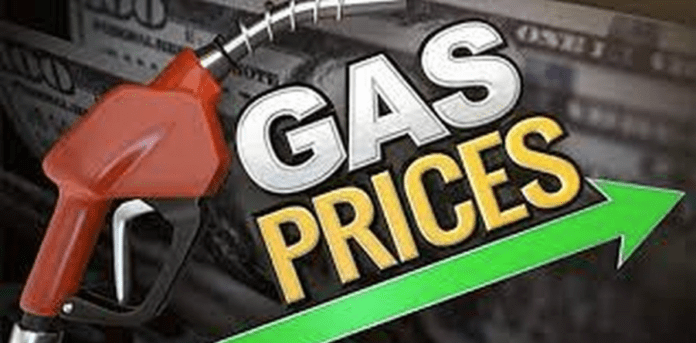Gas prices in Myrtle Beach have risen 15.5 cents in the past week, averaging $3.25 a gallon, according to GasBuddy.
On Sunday, the cheapest gas was $3.09 per gallon, and the most expensive was $3.49.
An expert at GasBuddy, however, anticipates relief for drivers soon.
It appears the spring top is in: gas prices have begun to cool off in many areas, according to Patrick De Haan, GasBuddy’s head of petroleum analysis. In the short term, few Americans need to worry about gas prices skyrocketing; the risk appears to be behind us, with relief to follow soon.
In the last week, gas prices in North and South Carolina remained similar.
The average price for gasoline in North Carolina is $3.36, while the average price for gasoline in South Carolina is $3.21.
How much have gas prices gone up since Biden was elected President?
Since President Biden took office, gas prices have been a hot topic. Many have noticed a significant increase at the pump.
But what exactly has caused this rise? Is it solely due to the policies of the Biden administration? Or are there other factors at play?
In this article, we’ll delve into the details. We’ll examine the average national gas price at the time of Biden’s inauguration and compare it to the current price.
We’ll also explore the various factors that have contributed to this increase. From global oil market trends to domestic energy policies, we’ll provide a comprehensive analysis.
By the end, you’ll have a clear understanding of the dynamics of gas prices under the Biden presidency. And how these changes have affected transportation costs.
Gas Prices at the Start of the Biden Presidency
When President Biden was inaugurated in January 2021, the average national gas price was $2.38 per gallon. This was during a time when the world was still grappling with the effects of the COVID-19 pandemic.
The pandemic had a significant impact on oil demand. With lockdowns in place and fewer people traveling, demand for gas was lower than usual. This resulted in relatively lower gas prices at the start of the Biden presidency.
Current Gas Prices Under the Biden Administration
Fast forward to the present day, the average national gas price has risen to $3.38 per gallon. This represents a significant increase in gas prices under the Biden administration.
Several factors have contributed to this increase, including the rebound in oil demand as economies reopen, supply chain disruptions, and international events affecting the global oil market. We will delve into these factors in the subsequent sections.
Analyzing the Increase: Percentage and Factors
The increase in gas prices since Biden took office is approximately 42%. This is a substantial rise, especially considering the relatively short period.
Several factors have contributed to this increase. Here are some of the key ones:
- Rebound in oil demand as economies reopen post-pandemic
- Supply chain disruptions due to the pandemic
- International events affecting the global oil market, such as OPEC decisions
Each of these factors has played a role in the current gas prices under the Biden administration. In the following sections, we will explore these factors in more detail.
Historical Context and Previous Administrations

To fully understand the current gas prices, it’s important to look at the historical context. Over the past decade, gas prices have fluctuated due to various factors, including global events and domestic policies.
Under previous administrations, we’ve seen both increases and decreases in gas prices. For instance, during the Obama administration, gas prices peaked in 2012 but then fell sharply due to the shale revolution.
Under President Trump’s term gas prices were cheap and gas was plentiful.
The Pandemic’s Impact on Oil Demand and Prices
The COVID-19 pandemic has had a significant impact on oil demand and prices. As lockdowns were implemented worldwide, demand for oil plummeted, leading to a sharp drop in prices.
However, as economies have started to reopen, demand surged. This sudden increase, coupled with supply chain disruptions caused by President Biden’s green policies, contributed to the rise in gas prices we’re currently experiencing.
Supply Chain Disruptions and Their Effects
Supply chain disruptions have played a significant role in the increase in gas prices. The pandemic caused a slowdown in oil production, leading to a decrease in supply.
As demand has rebounded faster than supply, prices have naturally increased. This imbalance between supply and demand is a key factor in the current gas price situation.
International Events and OPEC’s Role
International events, particularly decisions made by the Organization of Petroleum Exporting Countries (OPEC), have a significant impact on oil prices. OPEC’s decisions on oil production levels can cause prices to fluctuate.
For instance, if OPEC decides to cut production, this can lead to a decrease in supply and an increase in prices. Conversely, if OPEC increases production, this can lead to an increase in supply and a decrease in prices. These decisions are often influenced by global economic conditions and geopolitical events.
Biden’s Energy Policies and Their Potential Impact
President Biden’s energy policies have been focused on reducing the country’s reliance on fossil fuels and promoting renewable energy. This shift could potentially impact gas prices in the long term.
However, it’s important to note that changes in energy policy do not have an immediate effect on gas prices. The impact of these policies will be seen over time, as the country moves towards a more sustainable energy future.
Inflation and Gas Prices: What’s the Connection?
Inflation is a general increase in prices and fall in the purchasing value of money. It can have a direct impact on gas prices. When inflation rates are high, the cost of goods and services, including gasoline, tends to rise.
However, it’s not a one-way street. Rising gas prices can also contribute to inflation. As transportation costs increase, so does the cost of goods, leading to higher prices for consumers. This interplay between inflation and gas prices is a key factor in the overall economy.
Looking Ahead: Long-Term Trends and Transportation Costs
As we look to the future, several trends could influence gas prices and transportation costs. The transition to renewable energy and the rise of electric vehicles could decrease demand for gasoline.
On the other hand, geopolitical tensions and supply chain disruptions could continue to put upward pressure on prices. Understanding these dynamics can help us anticipate changes in transportation costs and make informed decisions.
Much will depend on the November Presidential elections.


